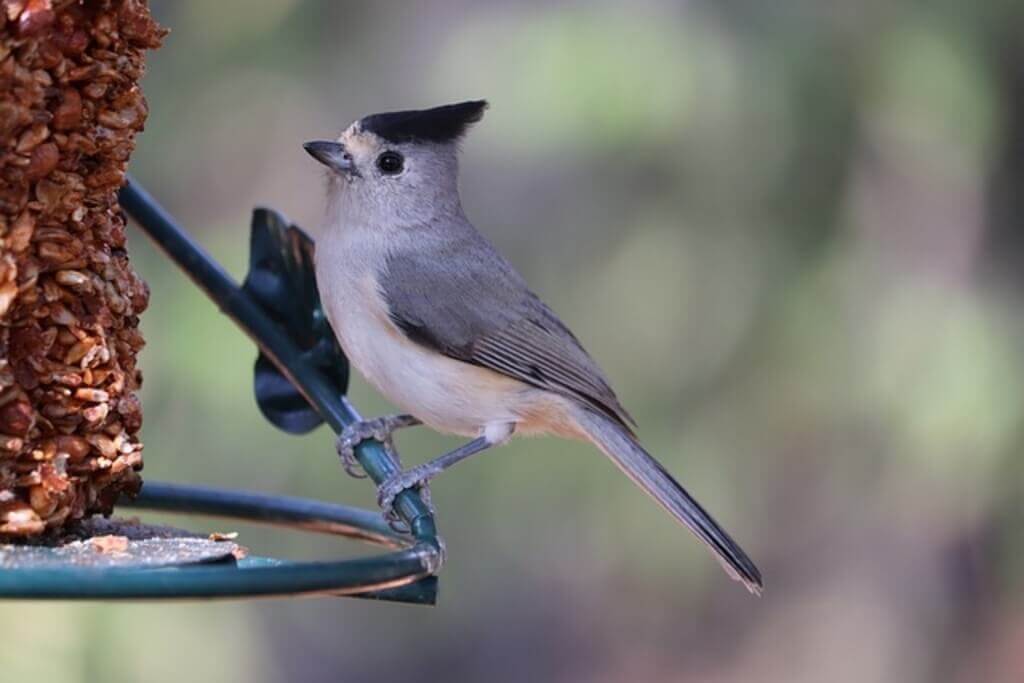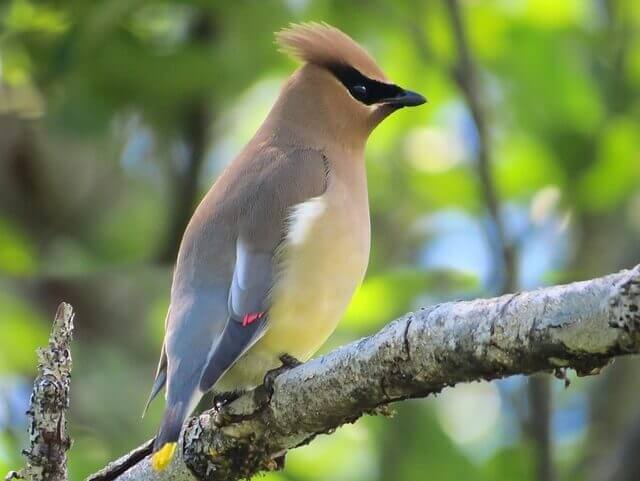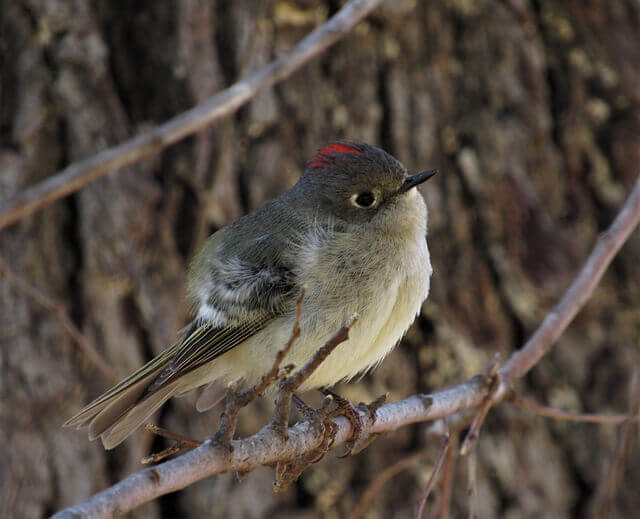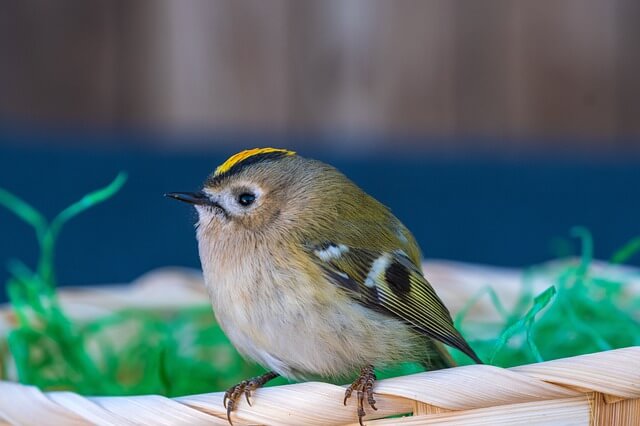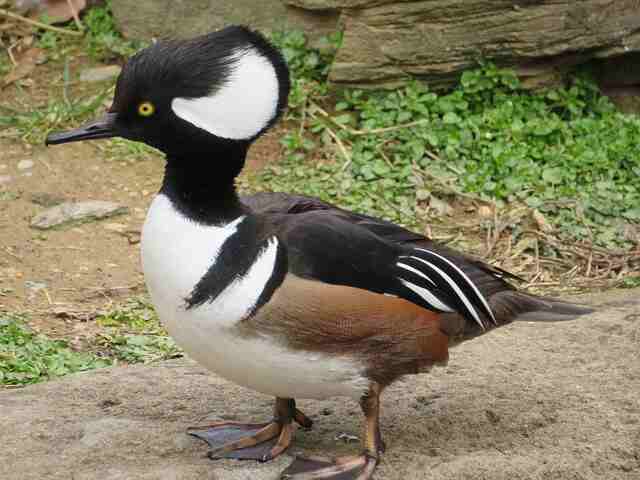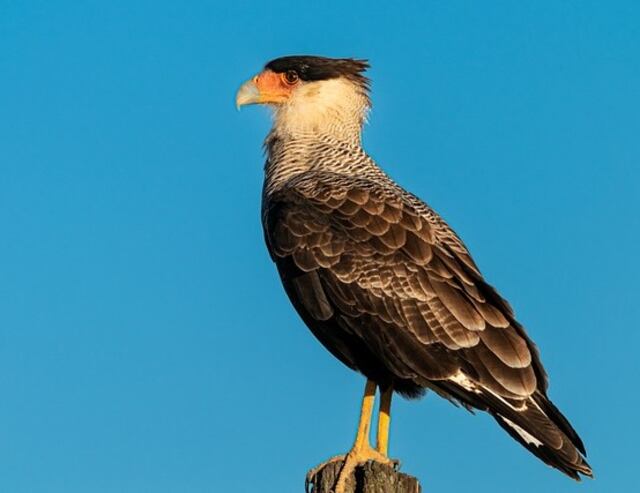When it comes to bird identification, one of the most important features to look out for is the crest. A crest is a distinctive feature on a bird’s head that can come in various shapes and sizes, from tufts of feathers to elaborate plumes and combs.
In this article, we’ll be exploring 16 birds with crests of North America. By learning more about the different types of crests and the birds that sport them, you’ll be better equipped to identify and appreciate the unique characteristics of each species. So let’s dive in and discover the fascinating world of crested birds!
Table of Contents
- 1 Types of Crests and Their Functions in Birds
- 2 Different Functions of Crests in Birds
- 3 Birds With Crests Of North America
- 3.1 Steller’s Jay
- 3.2 Blue Jay
- 3.3 Northern Cardinal
- 3.4 Tufted Titmouse
- 3.5 Oak Titmouse
- 3.6 Cedar Waxwing
- 3.7 Pileated Woodpecker
- 3.8 Vermilion Flycatcher
- 3.9 Ruby Crowned Kinglet
- 3.10 Gold-crowned Kinglet
- 3.11 Red-breasted Merganser
- 3.12 Hooded Merganser
- 3.13 Crested Caracara
- 3.14 Great Blue Heron
- 3.15 Great Crested Flycatcher
- 3.16 Double Crested Cormorant
- 4 Author
Types of Crests and Their Functions in Birds
In addition to serving as a distinguishing characteristic for bird identification, crests also play a variety of functional roles for different bird species. In this section, we’ll explore some of the different functions that crests can serve, such as communication, display, and camouflage.
Understanding the different functions of crests can give us a deeper appreciation for the many ways in which birds have adapted to their environments and evolved over time. Let’s take a closer look!
Different Functions of Crests in Birds
Crests can serve a variety of functions for different bird species. Some of the most common functions include:
- Communication: Crests can be used by birds to communicate with one another through visual cues. For example, a raised or lowered crest may convey aggression or submission, while a vibrating crest may indicate excitement or readiness to mate.
- Display: Many birds use their crests as part of elaborate courtship displays to attract mates. Crests can be fluffed up or waved around in an impressive fashion to show off the bird’s physical fitness and attractiveness.
- Camouflage: In some cases, crests may help birds blend in with their surroundings and avoid predators. For example, some birds with crest-like feathers on their heads, such as the Spruce Grouse, use them to mimic tree branches and blend into their forest habitats.
- Thermoregulation: Crests can help birds regulate their body temperature by trapping or releasing heat. For example, some species of owls have crests that they can raise or lower depending on the temperature of their surroundings.
- Intimidation: Some birds use their crests as a way to intimidate or frighten predators or other birds. For example, the Hooded Merganser has a large, fan-like crest that it can raise and lower to make itself appear larger and more intimidating to potential threats.
- Identification: In addition to helping us identify different bird species, crests can also serve as a way for birds to identify one another. Birds may use their crests to recognize members of their own species, or to distinguish between different social groups within their species.
| Bird | Crest Type | Function |
|---|---|---|
| Crested Titmouse | Tuft | Attracting mates |
| Northern Cardinal | Crest | Courtship display |
| Crested Caracara | Plume | Species recognition |
| Hooded Merganser | Crest | Attracting mates |
| Crested Auklet | Plume | Species recognition |
| Great Blue Heron | Plume | Courtship display |
| Crowned Sparrow | Crest | Species recognition |
| Hoary Marmot | Tuft | Camouflage |
| Harlequin Duck | Crest | Attracting mates |
| Tufted Puffin | Tuft | Attracting mates |
| Red-tailed Hawk | Crest | Species recognition |
| Northern Pintail | Crest | Attracting mates |
| Gambel’s Quail | Plume | Camouflage |
| King Eider | Crest | Attracting mates |
| Rock Ptarmigan | Tuft | Camouflage |
Birds With Crests Of North America
Steller’s Jay
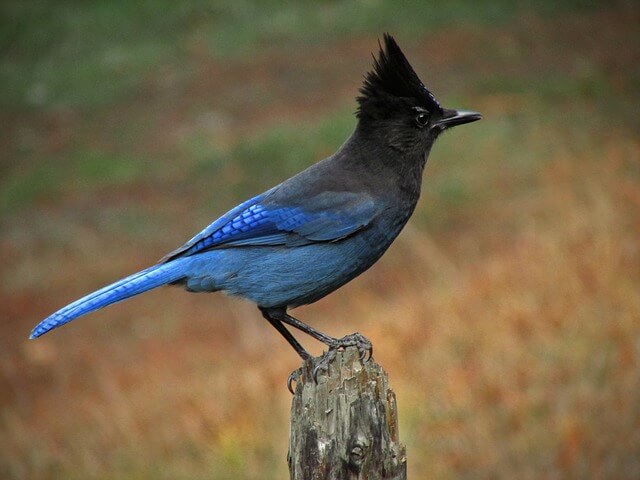
The Steller’s Jay is a bird found in the western United States throughout the northern Rockies, and Mexico, and one of the most recognizable species. Steller’s Jay are large, black-headed jays with a shimmering blue body, with a crest of feathers on its head, giving it an exotic appearance. Steller’s Jays are often found in scrub forests, chaparral brushlands, high elevation conifer, coniferous forests or woodlands, where they build their nests in trees or bushes.
They also live on prairies with scattered trees that provide perches for nesting as well as shade from the hot sun during summer months. Steller’s Jays eat mostly acorns, pine nuts, fruit, insects, and small rodents which they find on the ground or steal from other birds who store their food there. Steller’s Jays live up to 10–15 years old in the wild, but can live as long as 30 years when in captivity.
Read more: How to Attract Steller’s Jay to your Yard – Expert Tips!
Blue Jay
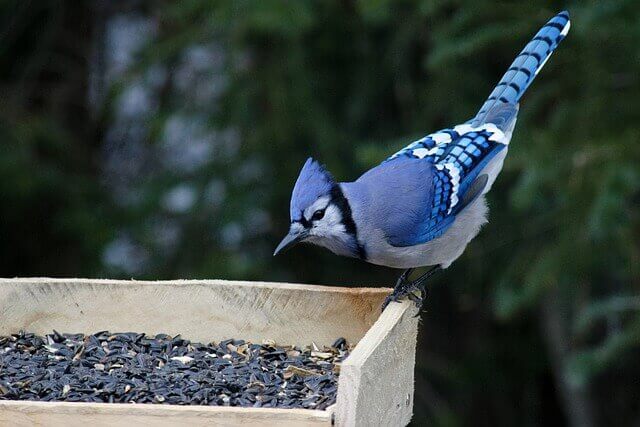
Blue Jays are very common birds in North America. They can be found anywhere from California to Canada, and they’re the only bird that can be found year-round in all 50 states. The blue jay is known for its bright blue crest and black throat feathers. They live mainly in woodlands, scrubby areas, suburban areas, and farmlands.
The diet of the Blue Jay consists of nuts, berries, insects, eggs, and chicks from other bird species. Blue Jays are common visitors to bird feeders where they can eat sunflower seeds, peanuts, safflower seed, or mixed seed blends. Blue Jays can be seen flying across fields looking for food during their migration season which begins in late March.
Read more:
Northern Cardinal

Watch out for the Northern Cardinal. It’s more common than you think, and it may be in your backyard. This bird can be found on the ground, or in trees or bushes as it hops from branch to branch. The Northern Cardinal is a large, mostly red bird that can be found all over North America, from Eastern Canada to Southern Mexico.
In addition to their bright coloration, they are recognizable by their pointed crest, which gives them an angry look. Males have a more pronounced crest than female cardinals. They typically feed on seeds, nuts and berries as well as small insects such as spiders or caterpillars, but occasionally eat some fruits.
Read more:
- 10 Best Bird Feeders for Cardinals: Expert Picks
- Where are Cardinals found? Best Spots to look
- Cardinal Bird Facts every Birdwatcher should know
Tufted Titmouse
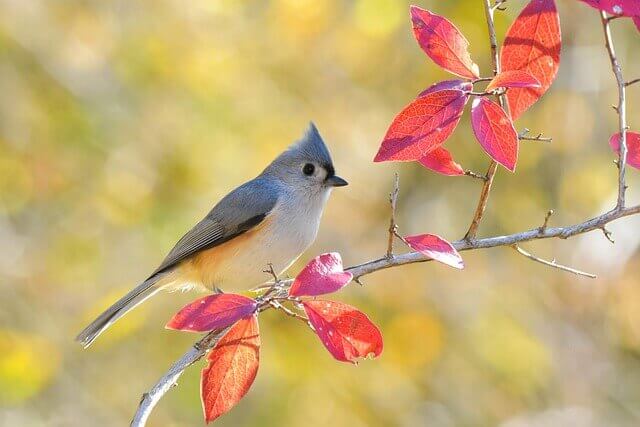
In the eastern United States, we have a cute little bird called the Tufted Titmouse. They are small, and you might not think twice about them as they fly around your backyard but don’t let their adorable exterior fool you! The Tufted Titmouse is known for eating insects like ants, beetles, spiders and crickets. They will also eat seeds from grasses or acorns that it cracks open with its beak to get at the seed inside.
They are known for their small beaks and fluffy, tufted crowns that give them a “fuzzy” appearance. Their preferred habitat includes deciduous forests, woodland edges, hedgerows, parks, suburban gardens and open woodlands with dense understory vegetation. Titmice can often be seen in residential areas and other man-made habitats during the winter months, when food becomes scarce.
Read more: How to Attract Tufted Titmouse to my Yard? (Explained)
Oak Titmouse
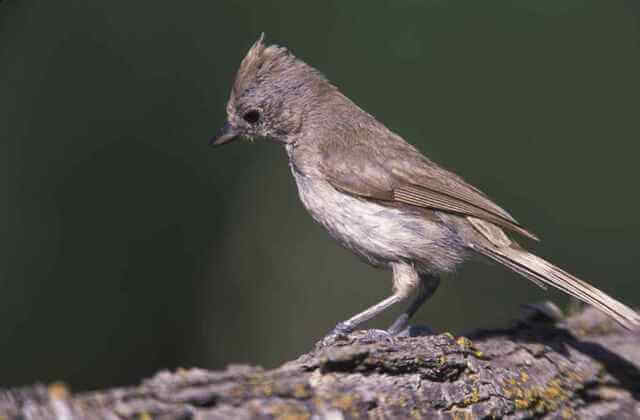
Oak Titmice are small grayish-brown birds with a tufted crest that can be lowered and raised when they feel threatened. They prefer to live in the dense forests and mixed woodlands throughout North America and eat insects, seeds, berries, and acorns. Oak Titmice will often feed on the ground, but they have also been known to feed on fruit or flowers from low-hanging branches, as well as fruits and nuts on tree limbs.
It’s very hard to tell males and females apart because they look so similar! They’re only found in some parts of California, Arizona, New Mexico, Texas, Oklahoma, Louisiana, and Kentucky. Oak Titmice have a distinctive call of “tsee tsee tsee” which is used to warn other Oak Titmice about predators nearby. The call becomes more intense as the predator gets closer to them or if they feel threatened by it.
Cedar Waxwing
This beautiful bird is called a Cedar Waxwing. It’s mainly brown, gray, and yellow with a facemask and tufted crest. This species of bird has an extensive breeding range from Alaska to the East Coast of North America, as well as parts of Asia. They are non-migratory in Canada, where their breeding season lasts from May to July. They are common in North America during the winter months, when they feed on berries of evergreen trees such as juniper.
The cedar waxwing feeds on berries and insects to keep their body weight up during winter months when food sources are scarce. These beautiful birds live in deciduous forests orchards, parks and gardens during the winter months of October to April as they migrate south into Mexico, Central America, Colombia, Ecuador and Peru to warmer weather.
Read more: How to Attract Cedar Waxwings to your Yard (Experts Tips)
Pileated Woodpecker
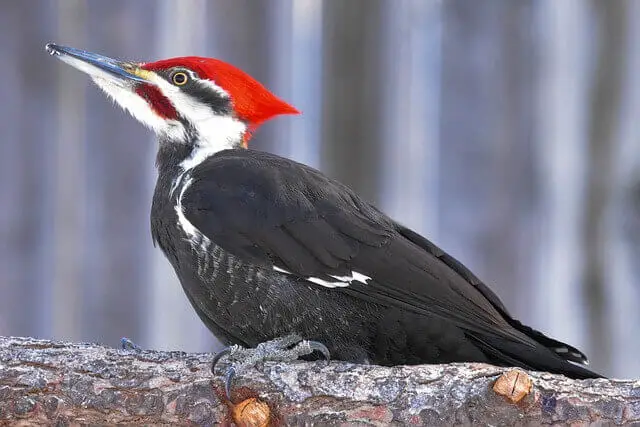
Pileated Woodpeckers are native to North America and have been seen in many parts of North America including Colorado, Florida, Maine, Minnesota, New York State, Texas and Virginia. They can be found in deciduous forests, woodland edges, urban parks, and suburban areas. They use their sharp beaks to drill into trees to find insects such as ants or beetle larvae, or any other ground-based insect that they can find, as well as small mammals and fruits.
They are the largest woodpecker in the United States, with a body length of 16–18 inches and a wingspan of 27–30 inches. The Pileated Woodpecker has a large red crest on its head, with black plumage throughout, and white stripes on the face, and down the neck. They are known to be very territorial when it comes to their nesting sites and feeding areas.
Read more: How to Attract Pileated Woodpeckers to your Yard (Fast)
Vermilion Flycatcher
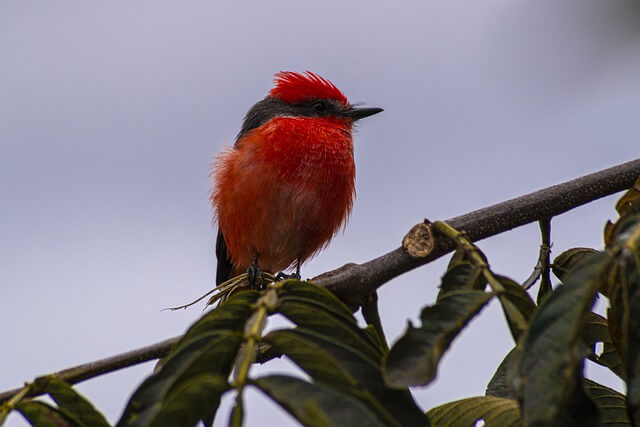
The Vermilion Flycatcher is a small, beautiful red bird with black wings and a tufted red crest. Averaging 5″ inches long with an average wingspan of 9.5″ inches wide, this bright little bird is well known for its striking appearance as well as its song, which sounds like “clear-sweet notes.” It lives in Southwestern United States, Central America, Southern Mexico, Southwestern United States and Eastern Guatemala.
The Vermilion Flycatcher feeds on insects such as grasshoppers, dragonflies and beetles. This can be found in fields of cacti or near the water’s edge, where it looks for its prey by perching motionless for long periods of time. They are very territorial and will defend their nests from predators at all costs. When this doesn’t work, they will fly away and start to alarm call in order to draw the attention of other nearby birds or animals.
Ruby Crowned Kinglet
The Ruby-crowned Kinglet is a small bird, typically between 3.5 and 4 inches long with wingspans of 6 to 7 inches, that can be found in North America. It is also known as the crowned Kinglet, and it has a crest on its head that resembles the shape of a king’s crown. The male Ruby-crowned Kinglet can be identified by his red cap, which he wears year round, while females have gray caps with streaks of white across them.
The bird lives mostly near water sources, such as ponds or streams, and typically eats insects such as ants, beetles, flies, spiders and other invertebrates from the ground or foliage around them. They will also eat berries and seeds when they are available. Watch for this small bird with an elegant song near your home. They are often mistaken for chickadees or other similar birds due to their appearance.
Gold-crowned Kinglet
The Gold-crowned Kinglet is a very small bird known for its golden colored crest. These birds are about 4 inches long and weigh less than 1 ounce. The Kinglets diet consists of insects as well as some fruit, nectar, and seeds when they’re available. They can be found in the western United States, Canada, Alaska, Mexico and Central America. In North America, these birds nest in coniferous forests from March to September.
They build their nests on tree branches and feed on insects during this time of year. During the winter months, they migrate southward to warmer climates. This beautiful little songbird is very skittish and usually stays in dense foliage or other places where it can’t be seen easily. It’s no wonder that most people don’t know what this kinglet looks like!
Red-breasted Merganser
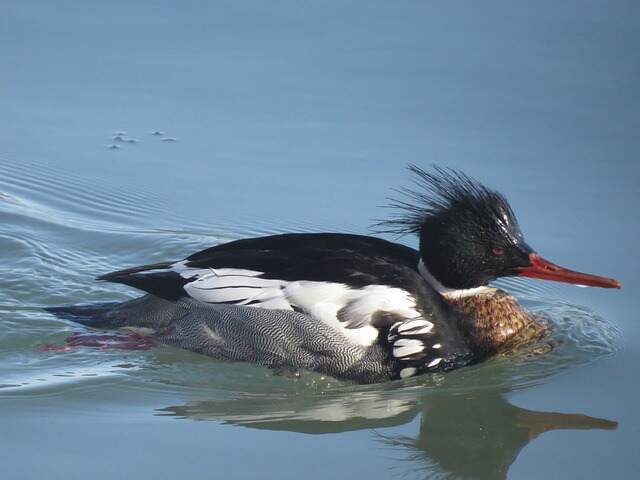
The Red-breasted Merganser is a medium-sized diving duck that is found in North America. They are known for their striking appearance, with a shaggy crest on their head that is especially prominent in males. The crest is made up of elongated feathers that can be raised or lowered to display their mood. Adult males are larger than females, with a length of 22–28″ inches and a wingspan of 30–36″ inches.
Females are slightly smaller, measuring 19–26″ inches in length, with a wingspan of 26–30″ inches. Their range extends across much of North America, from Alaska to the Gulf of Mexico. Red-breasted Mergansers prefer to live near coastal waters, such as bays, estuaries, and tidal flats. They are also found in inland lakes and rivers during the breeding season. Their diet consists primarily of fish, but they will also eat crustaceans and other aquatic invertebrates.
Hooded Merganser
The Hooded Merganser is a fascinating bird species that sports an impressive crest on its head. This crest is a unique feature that distinguishes the male from the female. The male’s crest is larger and more colorful than the female’s. They can be found across North America, ranging from Alaska to Mexico. They prefer to live in wooded swamps and marshes near streams and rivers.
Their diet mainly consists of fish, insects, crustaceans, and amphibians, which they catch by diving underwater. Their unique bill is serrated, which helps them catch and hold onto slippery prey. The Hooded Merganser’s crest serves several purposes, including attracting a mate and intimidating rivals. When the male is trying to impress a female, he will fan out his crest to show off its size and color. It’s a sight to behold and a true wonder of nature!
Crested Caracara
Ah, the majestic Crested Caracara! Did you know that this bird is a member of the falcon family and is found in North, Central, and South America? Its range stretches from Florida to the southernmost tip of South America. You’ll often find this bird in open areas like savannas, grasslands, and wetlands. They also enjoy perching on fence posts, trees, and other elevated areas to keep an eye out for prey.
Speaking of prey, the Crested Caracara is a scavenger and will eat anything from carrion to insects and small mammals. They’re also known to steal food from other birds and even raid garbage dumps. Despite being opportunistic feeders, they’re still an important part of the ecosystem. In fact, in some cultures, they’re even considered sacred birds! With their distinctive crests and powerful wings, the Crested Caracara is a true marvel of the avian world.
Great Blue Heron
Great Blue Herons are majestic birds with beautiful crests on their heads. They are found throughout North America, from Alaska to Mexico, and can be spotted in a variety of habitats, including wetlands, ponds, lakes, and rivers. These birds prefer to hunt in shallow water, where they wade stealthily and wait patiently for their prey. Their diet consists mainly of fish, but they also feed on small mammals, amphibians, and invertebrates.
Great Blue Herons are expert hunters and have a unique fishing technique. They will stand motionless in the water and wait for a fish to swim by, then quickly strike with their sharp beak and swallow the fish whole. Despite their large size and impressive wingspan, Great Blue Herons are graceful in flight and can often be seen soaring high in the sky. These birds are truly a sight to behold and are a favorite among birdwatchers and nature enthusiasts alike.
Great Crested Flycatcher

The Great Crested Flycatcher is a fascinating bird that can be found throughout the eastern half of North America, from southern Canada to the Gulf of Mexico. Its preferred habitat is deciduous forests with mature trees, where it builds its nest in tree cavities. However, it’s also known to venture into suburban areas. This bird is a flycatcher and feeds primarily on insects, particularly larger ones like moths and butterflies.
It also consumes some fruits and berries. The Great Crested Flycatcher is known for its distinctive call, which sounds like a harsh “wheep.” One interesting fact about this bird is that it lines its nest with a variety of materials, including snakeskin, cellophane, and even paper. Overall, the Great Crested Flycatcher is a remarkable bird with a unique crest on its head that makes it a joy to observe and appreciate in the wild.
Double Crested Cormorant
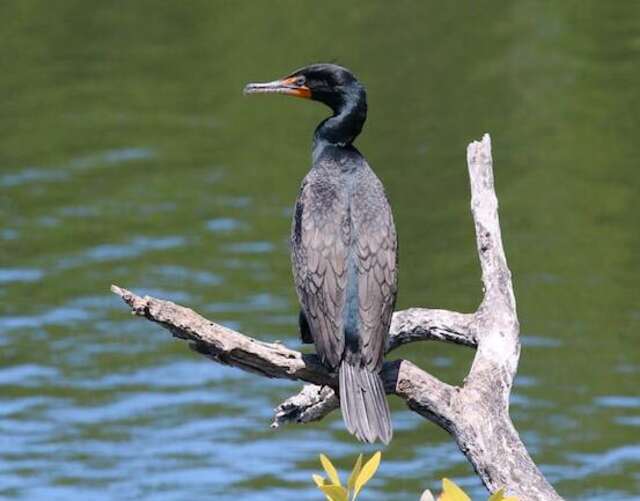
The Double Crested Cormorant is a striking bird with a unique appearance. Found throughout North America, from Alaska to Mexico, these birds can be seen near both freshwater and saltwater habitats. Their preferred habitats include coastal areas, lakes, rivers, and wetlands. They are excellent swimmers and divers, using their webbed feet to propel themselves through the water in search of prey.
Speaking of prey, the Double Crested Cormorant feeds mainly on fish, but also eats amphibians, crustaceans, and small mammals. Their signature double crest of feathers on their head is most prominent during breeding season, which occurs in the spring and summer. Overall, the Double Crested Cormorant is a fascinating bird with a distinctive look and interesting behaviors.
Related Post: Discover 32 Stunning Birds with Long Necks and Legs

